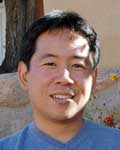
Tony Heinz
Professor of Applied Physics and of Photon ScienceDescription
Nanoscience and Quantum Engineering
We are pursuing research into the electronic and optical properties of a range of nanoscale systems, including zero-dimensional quantum dots, one-dimensional carbon nanotubes, and particularly two-dimensional layers and heterostructures. We are currently investigating 2D systems that include graphene and various transition metal dichalcogenides, such as MoS2. Our aim is to understand the electronic and optical properties of novel materials of reduced dimensionality and structures composed of these building blocks. Such nanoscale materials differ from bulk materials in various important ways: They experience strong quantum confinement effects that modify the properties of electrons and photons; they interact much more strongly with the external environment through electrostatic, mechanical, screening, and chemical interactions; and they tend to manifest much stronger many-body effects than bulk materials, as a consequence of the reduced dielectric screening. These underlying properties and the strong tunability of nanoscale materials render them very intriguing scientifically and endow them with technologically interesting properties. Our principal approach to the study of such nanoscale materials and structures is through the creative application of a variety of optical spectroscopy techniques, with a spectral range extending from the THz to the UV. Our approaches typically emphasize the ability to probe an individual nanostructures (such as a single carbon nanotube or 2D layer) or seek to elucidate the ultrafast dynamical process in these materials through femtosecond laser spectroscopy. In exploring the properties of novel properties of such materials and our ability to alter them through electrostatic gating, the dielectric environment, mechanical strain, etc., we also consider new applications in photonics. Working with our collaborators, we have, for example, developed new designs for optical modulators based on graphene integrated into a photonic crystal cavity. We are also exploring the potential role that valley-specific excitations and occupancy could play for electronic and photonic devices.
Condensed Matter Physics
We are interested in the fundamental properties of electronic states and phonons in novel nanoscale materials and structures, including carbon nanotubes, graphene, and the transition metal dichalcogenides, such as MoS2. We examine the materials primarily through optical spectroscopy of the electronic transitions (absorption, scattering, photoluminescence spectroscopy) and of phonons (THz, IR, and Raman spectroscopy). We probe the dynamics of the system using femtosecond pump-probe techniques across the spectral range. Issues of importance include understanding how quantum-confinement effects influence the electronic and vibrational states in these materials. We have also found that these materials typically exhibit very strong many-body effects, leading to the formation of tightly bond excitons, as well as more complex states, such as charged excitons and biexcitons. In collaboration with theory groups, we are developing a fundamental understanding of these effects in various material systems.
Lasers and Accelerators
We are interested in development of new spectroscopic capabilities based nonlinear optics and ultrafast pulses of coherent radiation. A topic of particular focus is the method of terahertz (THz) time-domain spectroscopy. In this technique, ultrafast visible laser pulses are converted into single cycles of radiation in the THz part of the electromagnetic spectrum by means of phase-matched optical rectification in suitable nonlinear materials. The resulting electric-field waveform is detected by electro-optic sampling using time-synchronized visible laser pulses. In addition to many application of this method for time-resolved spectroscopy of nanoscale materials, we have contributed to development of different aspects of the THz source and the electro-optic detection scheme. At the opposite end of the electromagnetic spectrum from THz radiation, we are seeking unique applications of coherent pulsed x-ray radiation from the LCLS light source at SLAC to probe ultrafast dynamics at surfaces and in nanoscale materials.
 Hideo Mabuchi
Hideo Mabuchi
 Mark A. Kasevich
Mark A. Kasevich
 Kathryn A. Moler
Kathryn A. Moler
 Yoshihisa Yamamoto
Yoshihisa Yamamoto
 Michel Digonnet
Michel Digonnet
 Stephen E. Harris
Stephen E. Harris